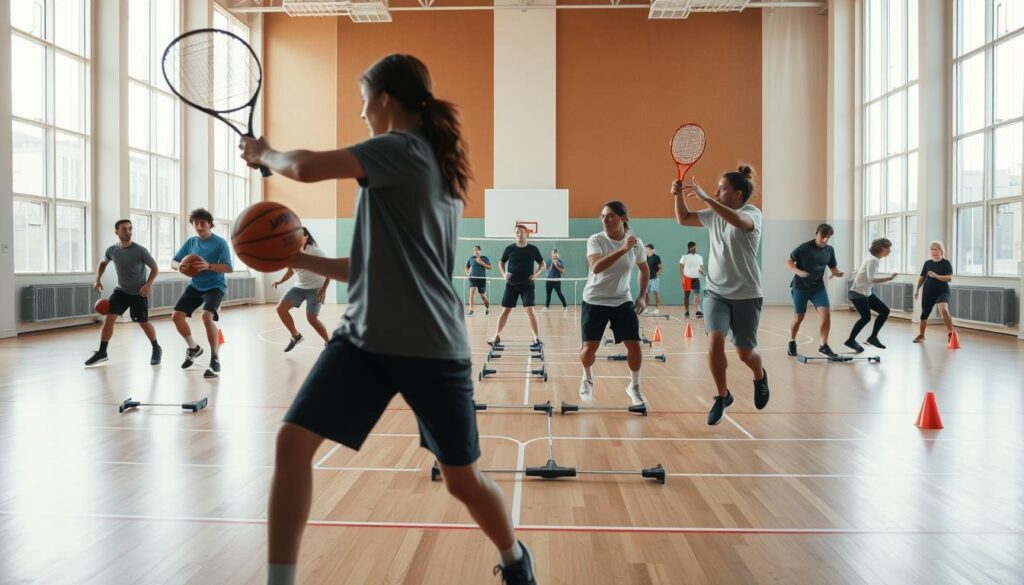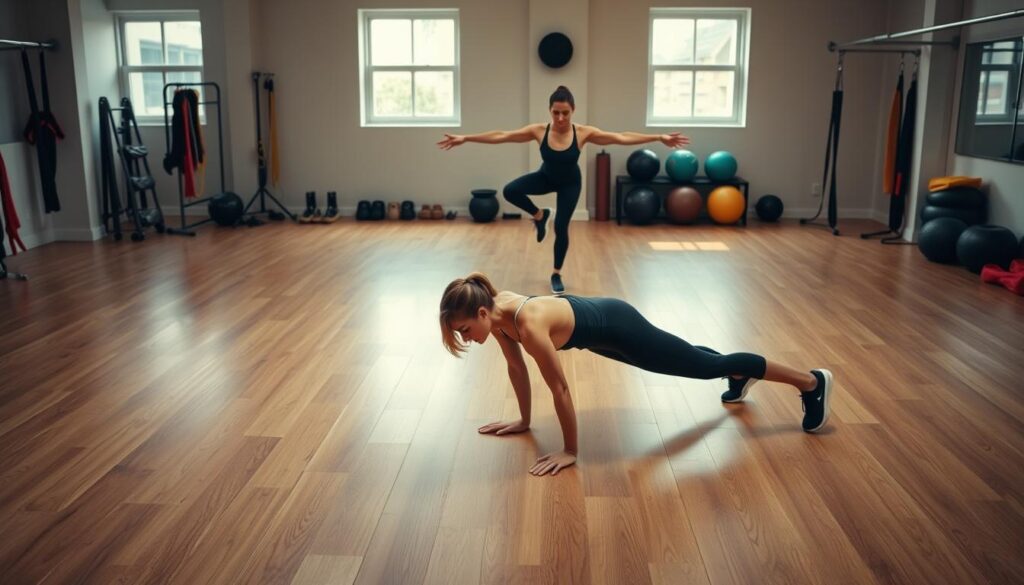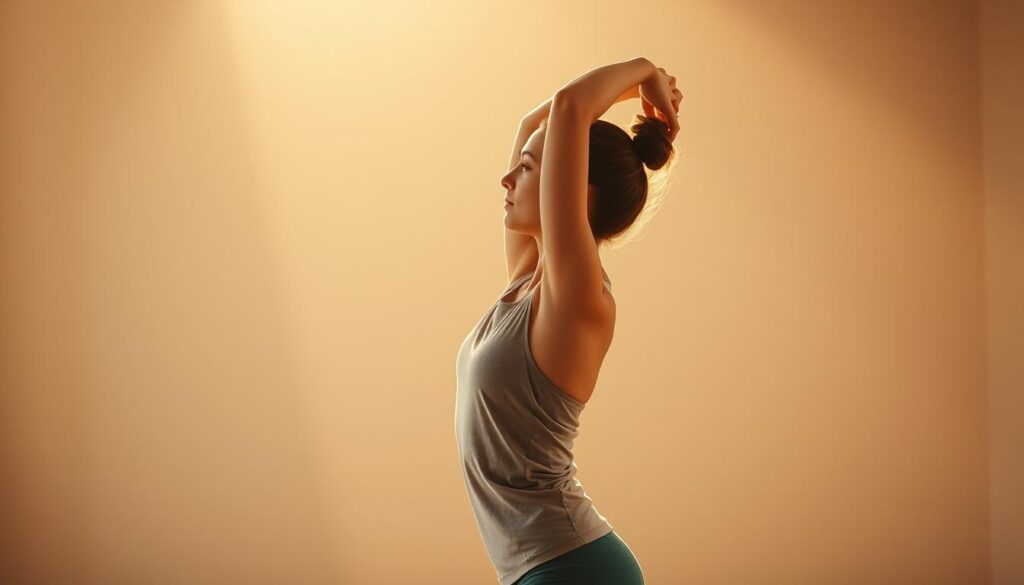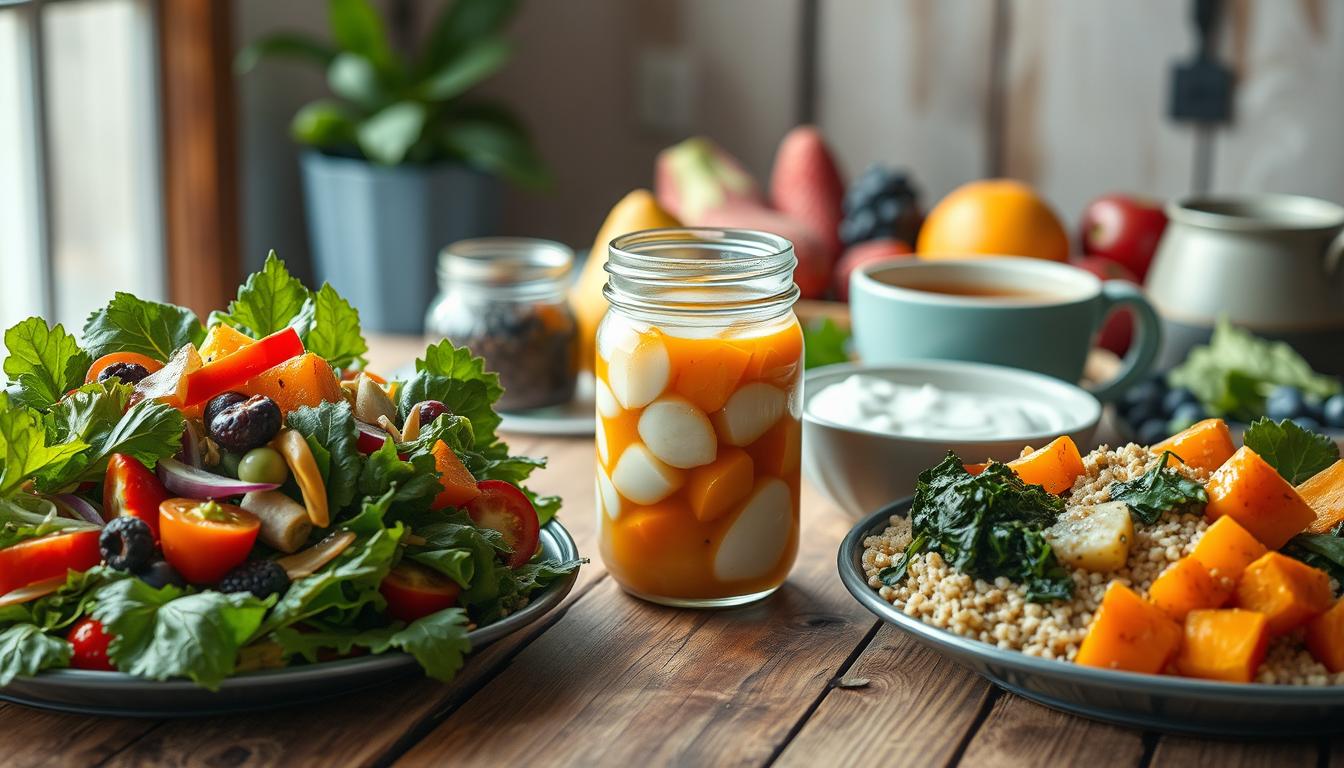Have you ever stumbled over a curb or lost your grip on a dish? Moments like these show how balance and coordination matter in our daily lives. I’ve tripped over my own feet more times than I can count. It’s clear how important these skills are, whether you’re chasing kids, gardening, or training for sports.
Declining balance doesn’t have to be a given. Science proves that specific exercises can improve stability and movement, regardless of age or fitness level.
These workouts aren’t just for athletes. Simple routines like standing on one leg or walking heel-to-toe strengthen muscles and improve body awareness. Balance and coordination exercises can make your mornings steadier, preventing falls and boosting confidence.
This guide offers practical steps for everyone. It combines exercises to improve balance and coordination with easy tips for lasting results.
Key Takeaways
- Balance and coordination workouts reduce fall risks and enhance daily movements.
- Exercises to improve balance and coordination are adaptable for all fitness levels.
- Simple drills like standing on one leg build stability effectively.
- Improved coordination boosts performance in sports and everyday tasks.
- Consistent practice leads to measurable progress in just weeks.
Understanding Balance and Coordination
Building a strong foundation starts with knowing the basics. Here’s how balance and coordination work together to keep you steady and in control.
What Is Balance?
Balance is your body’s ability to stay upright and stable. It relies on three key systems: the vestibular system in your inner ear, proprioception (body awareness), and visual input from your eyes. Disruptions in any of these can affect stability.
What Is Coordination?
Coordination means using different body parts together smoothly. Think of catching a ball or walking while texting. This skill depends on your brain sending precise signals to muscles and joints. Without it, even simple tasks become challenging.
Why Do They Matter?
- Everyday Safety: Poor balance increases fall risks, especially as we age. Balance exercises help maintain stability.
- Performance Boost: Athletes and dancers rely on coordination exercises to refine skills like throwing or dancing.
- Long-Term Health: Regular practice prevents age-related decline. Both skills are vital for tasks from climbing stairs to playing sports.
Without regular training, these abilities fade. Simple routines can strengthen them, improving quality of life and reducing injury risks.
The Importance of Balance in Daily Life
Balance is key for everyone, not just athletes. It helps us stay safe and active. For older adults, it lowers risks and boosts confidence. Let’s see how it impacts our daily lives.
“Falls are the leading cause of injury-related deaths in seniors.” – CDC
Reducing Fall Risk
Falls are a big problem, harming millions each year. Balance training exercises can help a lot. Seniors who do these exercises fall up to 37% less.
Simple moves like standing on one leg or walking heel-to-toe strengthen muscles. Tai chi combines balance and coordination exercises, improving ankle strength and reaction time. Every careful step reduces the risk of falls and fractures.
Enhancing Physical Performance
Good balance makes everyday movements better. Imagine walking on wet leaves or lifting groceries without stumbling. Improved stability means:
- Easier navigation of uneven terrain
- Better posture when lifting objects
- Reduced strain on joints during daily tasks
Yoga or Pilates mix balance and coordination exercises for seniors, boosting core strength. Even small improvements make tasks like bending over to tie shoes safer and easier.
The Role of Coordination in Movement
Coordination is the hidden power behind every move we make. It’s how our brain coordinates muscle actions, from simple tasks to complex sports. Without practice, this skill can disappear, making everyday activities more challenging. Let’s explore how coordination affects both our daily lives and high-stakes activities.
Activities That Require Coordination
- Typing: Fingers must hit keys without looking, relying on muscle memory.
- Cooking: Chopping vegetables while stirring a pot demands hand-eye focus.
- Dancing: Moving to music requires rhythm and spatial awareness.
- Walking on uneven ground: Adjusting steps to avoid tripping.
Coordination’s Impact on Sports Performance
Elite athletes, like tennis players, use quick reflexes developed through drills. A batter timing a swing or a soccer player passing under pressure rely on years of practice. For those who exercise casually, activities like juggling or balancing improve neural connections.
Studies show that older adults who practice coordination drills can reduce fall risks by 30%. Even simple actions, like tossing a ball against a wall, enhance focus and timing. Focusing on coordination training can improve both athletic performance and daily confidence.
Basic Exercises for Improving Balance
Starting with simple movements is key to building stability. These balance exercises are for everyone, focusing on core strength and awareness of space. Begin slowly and focus on proper form to avoid injury.
“Practice makes permanent—master these basics first.” — Balance Training Experts
Start with the Standing on One Leg exercise to engage your stabilizer muscles:
- Stand near a wall or chair for support.
- Raise one foot slightly, balancing on one leg for 10-15 seconds.
- Progress by closing your eyes or adding arm movements.
Repeat 3-5 times per leg. This strengthens ankles and improves proprioception, a key component of exercises to improve balance and coordination.
Next, try the Heel-to-Toe Walk:
- Walk in a straight line, placing your heel directly in front of the toes of your other foot.
- Stretch arms out for balance and focus on a fixed point ahead.
- Start with 5 steps forward, then reverse.
These drills build neural pathways that enhance coordination between your brain and muscles. Always warm up first and consult a professional if you have balance-related health concerns.
Advanced Balance Techniques to Try
After mastering basic moves, I move on to more challenging balance exercises. These workouts target deeper muscles and improve my ability to handle uneven surfaces. It’s important to focus on proper form before increasing intensity to avoid injuries and get the most out of the workout.
Single-Leg Deadlifts
I begin by standing with my feet hip-width apart and my core tight. I then bend forward at the hips, extending one leg behind as I reach for the ground. It’s crucial to keep my back straight and shoulders aligned, lifting slowly back up to standing.
Common errors include rounding the back or leaning too far forward. To make it harder, beginners can hold a light weight in one hand.
- Hold a dumbbell in one hand for resistance.
- Avoid arching the lower back during the hinge.
- Pause at the bottom to engage stabilizer muscles longer.
Bosu Ball Balancing
I use a Bosu ball to mimic unstable surfaces. I start with both feet on the dome side, shifting my weight from side to side while keeping my knees slightly bent. Once I feel steady, I move on to single-leg holds or squats.
I always prioritize control over speed, using a wall for support if needed. This equipment makes simple exercises into full-body challenges.
- Begin with 30-second holds before adding movement.
- Try reaching arms overhead while balancing for extra core engagement.
- Avoid locking knees to stay in control.
These workouts focus on both sides of the body, helping to balance muscle strength. They’re great for runners, dancers, or anyone looking to prevent falls. I adjust the number of reps or stance width based on my current skill level, ensuring steady progress without overdoing it.
Coordination Drills to Enhance Skills
Coordination drills help your body learn to move better. They make your brain work harder to do things like jump and catch. This improves your agility. Let’s look at two ways to get better at these skills.

Jump Rope Exercises
Begin with simple two-foot jumps. Then, try harder moves. Here’s what to do:
- Crossovers: Swing the rope while stepping sideways to build lateral movement.
- Double-Unders: Skip higher to get the rope to spin twice per jump, enhancing rhythm.
Doing these exercises often makes your movements smoother. It improves your timing and coordination.
Ball Toss Drills
Use a tennis ball or medicine ball for these exercises. Here’s how:
- Solo drills: Toss and catch while balancing on one leg to add challenge.
- Partner drills: Alternate tossing quickly to a partner to sharpen reaction time.
These drills make your hand-eye coordination better. They help your brain predict and adjust quickly.
Neurological studies show that consistent coordination drills boost neural efficiency, making complex movements feel natural.
Start slow and then get faster or more complex. Use smaller balls for beginners or faster rhythms for experts. With time, these drills will make you better at timing and spatial awareness.
Incorporating Yoga for Better Balance
Yoga combines physical postures with mindfulness. It’s a great way to improve balance exercises. Adults can enhance stability and coordination by focusing on alignment and breath.
Key poses target core engagement and spatial awareness. Try these balance exercises to strengthen your foundation:
- Tree Pose: Stand on one leg, pressing the sole of one foot into the inner thigh. Extend arms upward while focusing on a fixed point.
- Warrior III: Hinge forward from the hips, lifting one leg until your body forms a T-shape. Keep arms aligned with shoulders for balance.
- Eagle Pose: Cross one leg over the other, balancing while wrapping arms overhead. Hold for 30 seconds, then switch sides.
Proper breathing techniques amplify focus during these movements. Here’s how to integrate them:
- Inhale deeply through the nose, expanding the ribs sideways.
- Exhale slowly through the mouth, maintaining steady breaths during challenging poses.
These practices improve proprioception, helping adults perform daily tasks with greater ease. Consistency in yoga sessions fosters adaptability. This makes balance and coordination exercises for adults more effective over time.
Utilizing Strength Training for Stability
Strength training is key for better balance and coordination. It targets important muscle groups, improving stability and lowering injury risks. Focus on core and lower body exercises to boost functional movement.
Core Strengthening Exercises
Core muscles are like your body’s central pillar. Try these moves:
- Plank variations: Hold for 30 seconds, then try side planks or add weights.
- Bird-dog: Extend opposite arm and leg while keeping hips level.
- Anti-rotation presses: Use resistance bands to challenge core stability.

| Exercise | Focus Area | Benefit |
|---|---|---|
| Plank | Abdominals, obliques | Enhances trunk stability |
| Lunges | Quadriceps, glutes | Builds unilateral strength |
Lower Body Workouts
Lower body strength is crucial for balance in daily life. Focus on these exercises:
- Single-leg deadlifts (improve unilateral balance)
- Step-ups onto a bench (targets glutes and hamstrings)
- Calf raises (stabilize ankles)
Progressive overload is essential. Gradually increase resistance or difficulty. Use proper form to avoid muscle imbalances. Regular practice makes these exercises a routine that enhances stability.
The Benefits of Tai Chi for Balance and Coordination
I’ll look into how Tai Chi helps withexercises to improve balance and coordination. This ancient practice combines slow movements with deep breathing. It’s a great choice forbalance and coordination exercises for seniors.
By focusing on posture and smooth movements, Tai Chi boosts strength and mental sharpness. It also lowers the risk of falls.
Tai Chi Basics
Key elements include:
– Horse stance: Feet shoulder-width apart, knees bent to engage leg muscles
– Weight shifts: Gradual transfers between legs to improve stability
– Eight-shaped hand motions: Enhance upper-body coordination
How Tai Chi Works
Studies show it’s very effective. A 2023 study in *Journal of Gerontology* found a 34% drop in falls for those practicing twice a week. Here’s why:
| Mechanism | Impact |
|---|---|
| Muscle Activation | Strengthens quads and glutes via controlled stances |
| Proprioception | Improves spatial awareness through slow transitions |
| Mind-Body Link | Enhances focus, reducing cognitive decline risks |
Practitioners get physical strength and mental clarity. The meditative rhythm helps the body anticipate movements. This skill is key for everyday tasks like walking or reaching.
By adding Tai Chi to their weekly routine, seniors can see lasting improvements in balance. This is done without the strain of high-impact exercises.
Stretching for Flexibility and Balance
Keeping muscles flexible is crucial for balance as we get older. Many adults don’t stretch, not knowing how tight muscles can affect posture and balance. Doing balance and coordination exercises for adults and stretching helps joints move better and lowers the chance of falls.

Importance of Flexibility
Stiff muscles limit natural movement, making the body work harder. For instance, tight calf muscles can affect ankle mobility, which is key for balance exercises. Studies reveal that older adults with more flexibility have 30% fewer injuries related to balance. Adding stretches to your daily routine can fight muscle shortening that comes with age.
“Flexibility isn’t just for athletes—it’s a lifeline for maintaining independence as we age.”
Recommended Stretching Routines
Begin with these exercises to improve stability and movement:
- Seated Toe Touch: Sit with legs straight, reach for toes, hold for 20 seconds. It loosens hamstring tension and enhances forward bending.
- Doorway Pectoral Stretch: Stand in a doorway, arms at 90°, to stretch chest muscles and ease upper back strain.
- Figure-Four Stretch: Sit cross-legged, switch legs, to loosen hip rotators and balance gait.
Do dynamic stretches (like leg swings) before exercising and static stretches after. Spend 10-15 minutes each day on ankles, hips, and hamstrings. Move slowly and carefully to avoid stretching too much.
Combine these stretches with core exercises for better stability. Be gentle and consistent. It’s better than doing intense stretches rarely.
Tracking Progress in Balance and Coordination
I suggest starting with simple steps to track balance and coordination improvements for seniors. Regular monitoring helps seniors see small wins and stay motivated.
Setting Realistic Goals
Begin by measuring baseline performance. For example, time how long you can stand on one leg or complete a coordination exercise. Write down these numbers to compare later.
- Set weekly goals, like adding 5 seconds to a single-leg stance.
- Focus on functional goals, such as walking without assistance or holding poses longer.
- Adjust timelines based on your current fitness level. Patience is key.
Measuring Improvement
Use tests like the Timed Up and Go or a single-leg stance with eyes closed to assess balance. Coordination exercises like alternating hand taps can show progress over time.
“Small gains matter. Celebrate each milestone, even if it’s just 2 seconds longer on one foot.” — Dr. Emily Carter, Geriatric Physiotherapist
Track metrics in a journal. Note improvements every two weeks. Consistency builds neural pathways needed for better stability and control.
Tips for Maintaining Balance and Coordination
Improving balance and coordination takes effort. Small, regular practices lead to lasting results. Adding key exercises to your daily routine helps adults stay on track without long workouts.
Consistency Is Key
Short daily sessions are more effective than intense, occasional workouts. Try standing on one foot while brushing teeth or walking heel-to-toe in line. These activities turn daily tasks into balance exercises.
Even five minutes a day can make a big difference. It strengthens your body’s ability to stay steady and agile.
Staying Motivated in Your Routine
Keep your practices interesting by mixing drills with familiar moves. Try yoga poses, ball toss drills, and core workouts to avoid boredom. Use a journal or app to track your progress and see how far you’ve come.
Having a workout buddy can boost your motivation. Remember, obstacles like busy schedules or plateaus are normal. Adjust your routine as you get better.
Balance and coordination can be improved at any age. Small, consistent efforts lead to stronger stability and confidence over time.
FAQ
What are some effective exercises to improve balance and coordination?
How often should I do balance and coordination workouts?
Are there specific balance and coordination exercises for seniors?
How can yoga help with balance and coordination?
What role does strength training play in improving balance?
What are some simple coordination exercises for home practice?
How can I track my progress in balance and coordination exercises?
Did you like this article? See also: https://powerfitguide.com/how-to-increase-cardiovascular-endurance/







